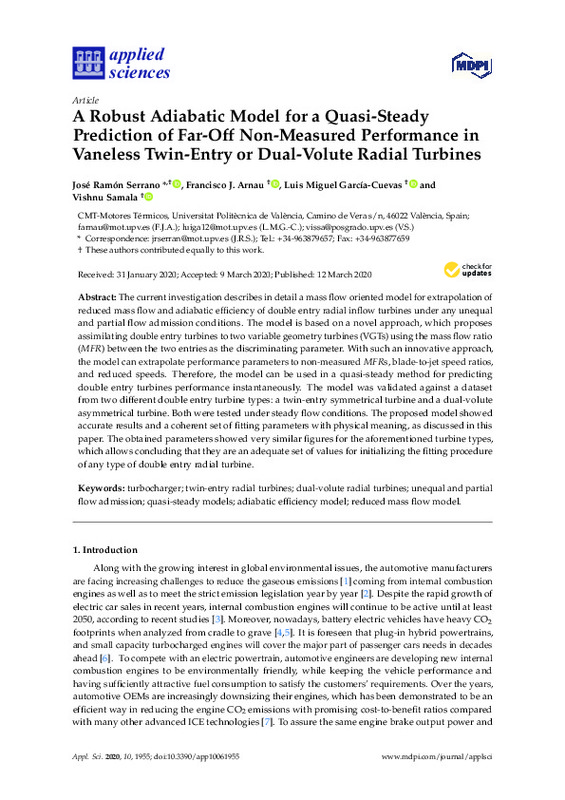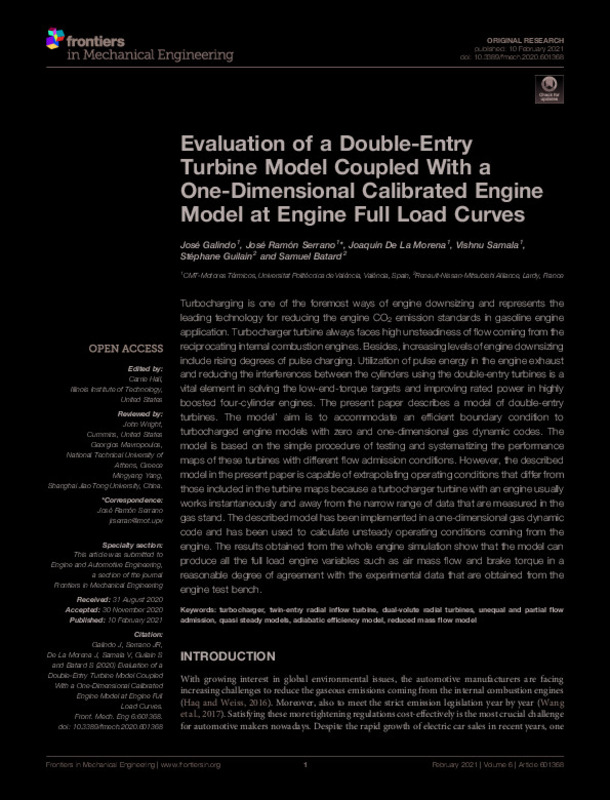Serrano Cruz, JR.; Arnau Martínez, FJ.; Fajardo, P.; Reyes Belmonte, MÁ.; Vidal, F. (2012). Contribution to the Modeling and Understanding of Cold Pulsating Flow Influence in the Efficiency of Small Radial Turbines for Turbochargers. Journal of Engineering for Gas Turbines and Power. 134(10):1-11. https://doi.org/10.1115/1.4007027
Por favor, use este identificador para citar o enlazar este ítem: http://hdl.handle.net/10251/81943
|
Título:
|
Contribution to the Modeling and Understanding of Cold Pulsating Flow Influence in the Efficiency of Small Radial Turbines for Turbochargers
|
|
Autor:
|

 Serrano Cruz, José Ramón
Serrano Cruz, José Ramón

 Arnau Martínez, Francisco José
Fajardo, Pablo
Reyes Belmonte, Miguel Ángel
Vidal, Fabrice
Arnau Martínez, Francisco José
Fajardo, Pablo
Reyes Belmonte, Miguel Ángel
Vidal, Fabrice
|
|
Entidad UPV:
|
Universitat Politècnica de València. Instituto Universitario CMT-Motores Térmicos - Institut Universitari CMT-Motors Tèrmics
Universitat Politècnica de València. Escuela Técnica Superior de Ingeniería del Diseño - Escola Tècnica Superior d'Enginyeria del Disseny
|
|
Fecha difusión:
|
|
|
Resumen:
|
In the present paper, an unsteady approach to determine the performance of a small radial inflow turbine working under cold pulsating flow is presented. It has been concluded that a reasonably good characterization of ...[+]
In the present paper, an unsteady approach to determine the performance of a small radial inflow turbine working under cold pulsating flow is presented. It has been concluded that a reasonably good characterization of turbine behavior working with pulsating flow can be obtained using, in a quasi-steady way, models of the turbine isentropic efficiency and turbocharger mechanical efficiency. Both models have been fitted using data obtained from a steady flow characterization procedure. Turbocharger-measured parameters from the cold pulsating flow campaign have been compared with the ones obtained from one-dimensional gas dynamics computational modeling. The modeling approach is based on quasi-steady isentropic and mechanical efficiency models. Reasonably good accuracy in compressor and turbine variables prediction has been obtained for most of the operative conditions. Influence of amplitude and frequency of the pulsating flow over the instantaneous and average turbine efficiency has been studied to put some light on the analysis of the involved physical phenomena. The main conclusion is that the biggest effect of unsteady flow on turbine efficiency is through the influence on blade jet to speed ratio. It has been also concluded that, for the same average blade jet to speed ratio, pulses' amplitude does not influence turbine efficiency when it is closed, but does at other variable geometry turbine (VGT) positions. The effect of pulses' frequency is less evident and only influences VGT performance at the highest VGT openings.
[-]
|
|
Palabras clave:
|
Computational modeling
,
Effect of pulse
,
Flow characterization
,
Isentropic
,
Isentropic efficiency
,
Mechanical efficiency
,
Modeling approach
,
Physical phenomena
,
Pulsating flow
,
Quasi-steady
,
Radial inflow turbine
,
Radial turbines
,
Speed ratio
,
Turbine efficiency
,
Variable geometry turbines
,
Variables prediction
,
Cold working
,
Efficiency
,
Superchargers
,
Turbomachine blades
,
Turbine components
|
|
Derechos de uso:
|
Cerrado |
|
Fuente:
|
Journal of Engineering for Gas Turbines and Power. (issn:
0742-4795
)
|
|
DOI:
|
10.1115/1.4007027
|
|
Editorial:
|
American Society of Mechanical Engineers (ASME)
|
|
Versión del editor:
|
http://dx.doi.org/10.1115/1.4007027
|
|
Código del Proyecto:
|
info:eu-repo/grantAgreement/MICINN//DPI2010-20891-C02-02/ES/ELABORACION DE MODELOS TERMOFLUIDODINAMICOS Y TECNICAS EXPERIMENTALES PARA DESARROLLAR UN COLECTOR DE ESCAPE MULTIFUNCIONAL CON UN FILTRO DE PARTICULAS DIESEL INTEGRADO/
|
|
Agradecimientos:
|
The authors wish to thank part of the economical support for this work to Spanish Grant DPI210-20891-C02-02 from Ministerio de Ciencia e Innovacion.
|
|
Tipo:
|
Artículo
|






![[Cerrado]](/themes/UPV/images/candado.png)




